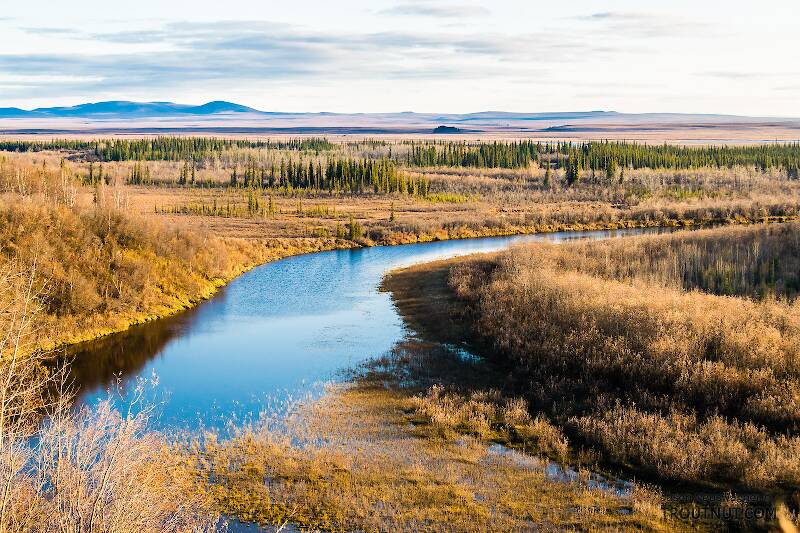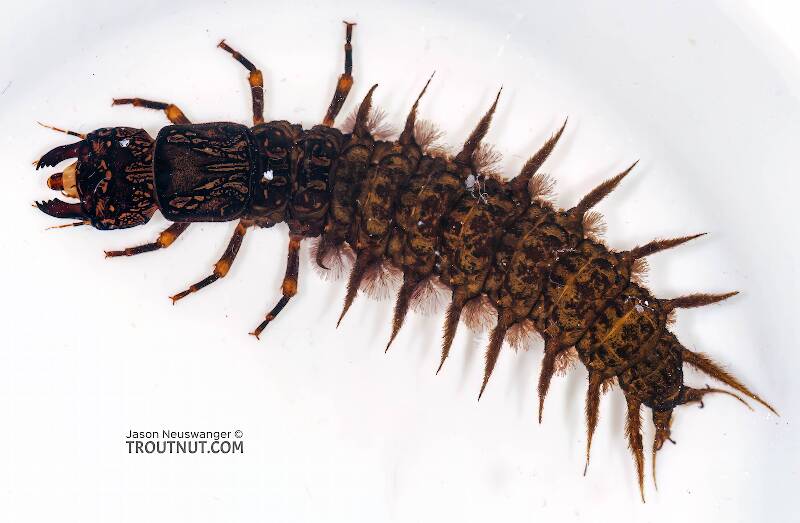
Salmonflies
Pteronarcys californica
The giant Salmonflies of the Western mountains are legendary for their proclivity to elicit consistent dry-fly action and ferocious strikes.
Featured on the forum

This dun emerged from a mature nymph on my desk. Unfortunately its wings didn't perfectly dry out.

Troutnut is a project started in 2003 by salmonid ecologist Jason "Troutnut" Neuswanger to help anglers and
fly tyers unabashedly embrace the entomological side of the sport. Learn more about Troutnut or
support the project for an enhanced experience here.
This topic is about the Hellgrammite Genus Corydalus
The largest and most well-known hellgrammites belong to this genus, although in my collecting experiences the fishflies of Nigronia seem to be more common in trout streams.Example specimen
Sprattoo on Jun 5, 2007June 5th, 2007, 7:07 am EDT
The First time I saw one of these things was as a kid. We were playing around a woolen mill in old Kezar Falls Maine.
Turning over a damp old pile of wool revealed a number of adult Hellgrammites. At the age of 12 or 13 these were the scariest things I had ever seen.... still very intimidating. I remember trying to get them to bite sticks and my shoe... which they happily did once I started poking them.
Now at the age of thirty *mumble mumble* This insect has come into my life again.
After opening my little tackleshop and selling flies and gear for about a year, it was an embarrassment that I couldn't catch the Browns surfacing all over the place down on the river.
I finally got one by accident, cut open its belly and found... thats right... A dobsonfly nymph.
Although I believe they were really feeding on dragonfly or damselfly nymphs (as they were chasing and feeding near the top)
The story of my trouts belly told a different tale.
Some time at the tying bench, with a few pieces of yarn and marabou and now those old browns are no problem at all!
Turning over a damp old pile of wool revealed a number of adult Hellgrammites. At the age of 12 or 13 these were the scariest things I had ever seen.... still very intimidating. I remember trying to get them to bite sticks and my shoe... which they happily did once I started poking them.
Now at the age of thirty *mumble mumble* This insect has come into my life again.
After opening my little tackleshop and selling flies and gear for about a year, it was an embarrassment that I couldn't catch the Browns surfacing all over the place down on the river.
I finally got one by accident, cut open its belly and found... thats right... A dobsonfly nymph.
Although I believe they were really feeding on dragonfly or damselfly nymphs (as they were chasing and feeding near the top)
The story of my trouts belly told a different tale.
Some time at the tying bench, with a few pieces of yarn and marabou and now those old browns are no problem at all!
www.sprattoo.com
Wiflyfisher on Jun 5, 2007June 5th, 2007, 11:40 am EDT
I have witnessed at certain times of the year on certain stretches of some of my favorite Midwestern waters that trout are keyed in on hellgrammites. A good imitation at those times can get some awesome strikes from big trout. I am always amazed at these times how many hellgrammites the trout can inhale and still want more!
My own conclusion was at certain times the hellgrammites must expose themselves and get caught in the currents. Trout hiding behind rocks and alongside current tongues are gorging themselves on these large, helpless drifting morsels. A sudden dash and strike to a weighted marabou wooly bugger can really make the pain of casting these things worth while.
My own conclusion was at certain times the hellgrammites must expose themselves and get caught in the currents. Trout hiding behind rocks and alongside current tongues are gorging themselves on these large, helpless drifting morsels. A sudden dash and strike to a weighted marabou wooly bugger can really make the pain of casting these things worth while.
John S.
https://WiFlyFisher.com
https://WiFlyFisher.com
Quick Reply
Related Discussions
Topic
Replies
Last Reply
1
May 17, 2016
by Bnorikane
by Bnorikane
1
Mar 10, 2007
by Troutnut
by Troutnut
0
Dec 7, 2006
by Troutnut
by Troutnut
5
Jun 28, 2011
by PaulRoberts
by PaulRoberts
2
Mar 10, 2008
by Joec
by Joec
3
Jan 2, 2021
by Wbranch
by Wbranch



